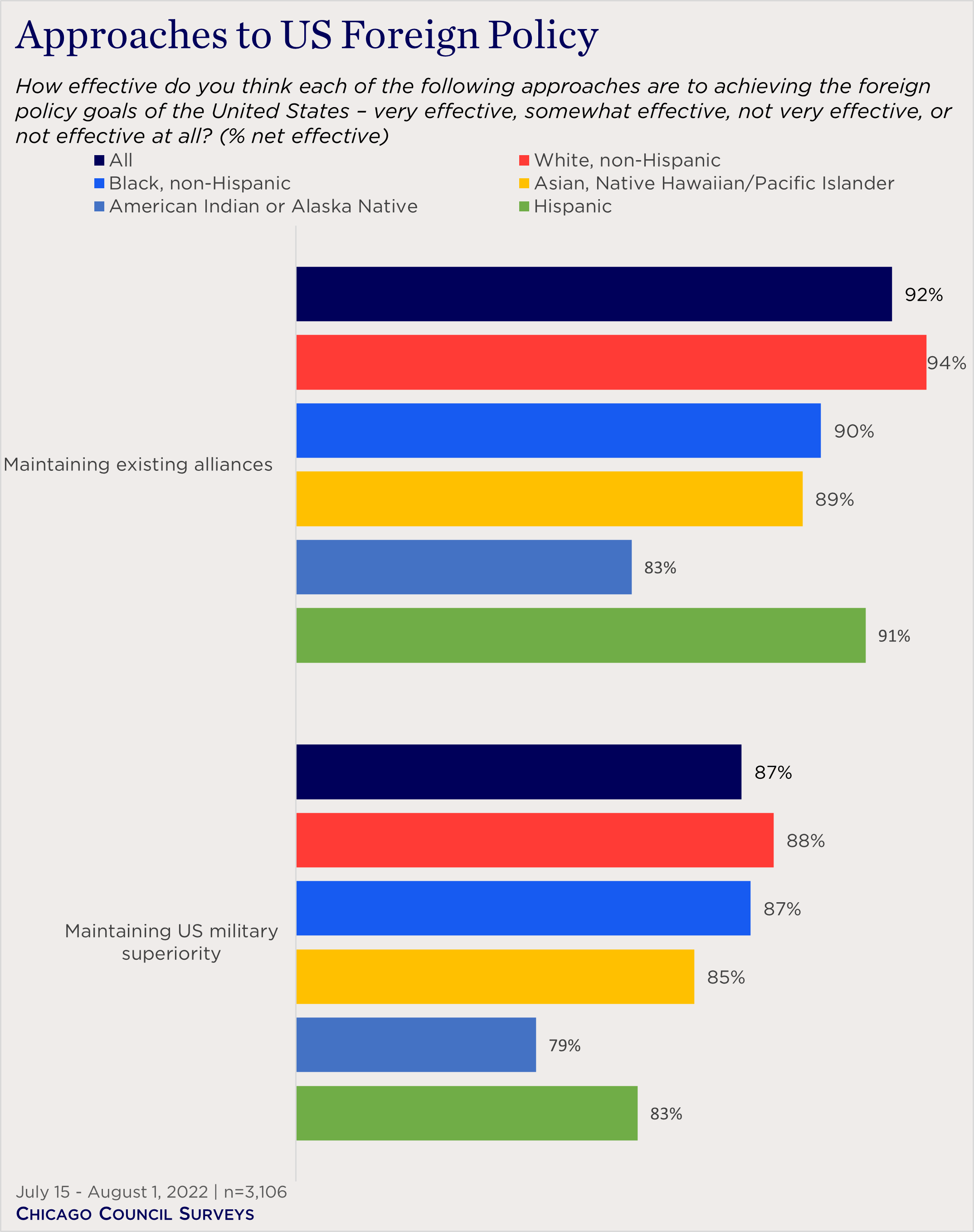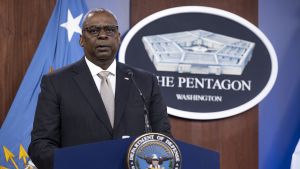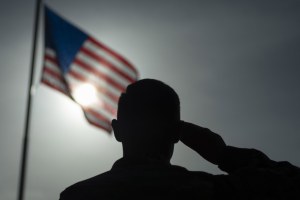Most Americans see military power and security alliances as an effective way to achieve foreign policy goals, but differences emerge about when to deploy troops.
The United States is more racially diverse today than it has been at any time in its past. As a result, definitions of national security threats are shifting, highly politicized, and closely tied to identity. To better understand how this diversity feeds into the use of force, the Chicago Council on Global Affairs and the New America Foundation have partnered to conduct novel research on the views of white, Black, Asian, Hispanic, and Native Americans as part of the 2022 Chicago Council Survey.
Key Findings
-
Solid majorities among most racial groups consider maintaining alliances and US military superiority to be at least somewhat effective in achieving US foreign policy.
-
About two-thirds or more from all racial groups support the US military presence abroad in Japan, South Korea, Germany, and Poland.
-
But there are significant differences in support across races about when US troops should be deployed. Asian Americans tend to report the most support for the use of force in each scenario presented, followed by white Americans. Native Americans, Black Americans. Hispanic Americans report the least comfort with the use of force in the scenarios presented.
Agreement across Race on Effectiveness of Alliances and US Military Power
Americans across racial categories consider some potential hard power elements to be effective in achieving foreign policy goals, including maintaining existing security alliances and US military superiority. Between eight and nine in 10 among most racial groups consider maintaining alliances at least somewhat effective; about half consider alliances to be very effective. And at least eight in 10 consider maintaining US military superiority to be at least somewhat effective; a third of American Indian and Native Alaskan and about half among other racial groups say this is very effective.

To underwrite these capabilities, Americans tend to support maintaining the current defense budget (38% overall), with an additional 29 percent saying the defense budget should be expanded. Just over a quarter (26%) say the defense budget should be cut back.
White (41%) and Asian Americans (40%) are most likely to say the defense budget should be kept about the same. At the same time, though, Asian Americans are also more likely than other groups to say defense spending should be reduced (34%) and the least likely to say it should be expanded (21%). American Indians/Native Alaskans are most likely to say it should be expanded (36%).

Agreement across Race on Effectiveness of Alliances and US Military Power
Generally speaking, most Americans across races seem to see benefits from an overseas US military presence. About two-thirds or more from all racial groups believe the United States should have long-term bases in Japan, South Korea, Germany, and Poland. Overall support for bases in Turkey, Australia and Poland is at lower levels. Black and Asian Americans express somewhat lower support than other Americans for bases in Australia and Poland, but at least half among these groups endorse bases there.
Differences Regarding the Use of US Troops
While majorities across racial groupings consider security alliances, a global military presence, and military superiority to be effective foreign policy approaches, differences emerge when it comes to the specific use of US troops abroad.
Overall percentages show that Americans are most united in the choice to use US troops to help defend a NATO ally such as one of the Baltic states if it is attacked by Russia (61%); to help defend South Korea if it is attacked by North Korea (55%); and to help Ukraine defend itself against Russia (51%). Overall minorities would support using US troops if China invaded Taiwan (44%) or to combat terrorist groups in Somalia (43%).
Looking at the data by race, several patterns emerge:
- Asian Americans tend to be the most likely to support the use of force in each scenario presented. They are especially more supportive than others when it comes to aiding Taiwan in the event of an invasion by China (53%)—the only racial group to endorse the use of US troops in this case.
- By contrast, African Americans are less inclined to send US troops into combat, with no more than half backing the use of US troops to defend Korea (46%), Taiwan (33%), or a NATO ally (48%).
- Hispanic Americans are also slightly less supportive of using US troops to defend South Korea (47%) or Taiwan (41%), but favor sending US troops to aid Ukraine (55%) and NATO allies (54%). They are divided over sending US troops to combat terror in Somalia (50% favor, 48% oppose).
- Native Americans tend to be the least likely to support using US troops abroad, regardless of the scenario presented.

Closeup on Ukraine: Widespread Support for Non-Military Assistance
While the use of force question above asked solely about supporting Ukraine with the use of US troops, the Chicago Council 2022 survey also included a question with both diplomatic and military options to address the situation. Similar majorities across the racial groupings favor diplomatic options such as taking in refugees, providing economic and military aid to Ukraine, and increasing sanctions on Russia.
Native Americans are the exception. They are notably less likely to favor sending arms to Ukraine (59% vs. 72% overall), accepting Ukrainian refugees into the US (54% vs. 76% overall) and providing economic aid to Ukraine (49% vs. 71% overall). However, they broadly support increased sanctions on Russia (71%) and are slightly more likely than most Americans to support sending US troops to Ukraine (46%)1 .

The limited differences on US policy toward Ukraine are an interesting contrast to other questions regarding support for Kyiv such as whether the US should support Ukraine for “as long as it takes,” even at a cost to US households. Here, white (63%) and Asian Americans (61%) are the most likely groups to favor supporting Ukraine despite the costs. By contrast, African Americans (49%), Native Americans (48%), and Hispanic Americans (48%) are divided, with just under half choosing each side of the issue.

Closeup on Taiwan: Asian Americans Most Supportive
Americans are more divided along racial and ethnic lines when it comes to US policy toward Taiwan in the event of an invasion by China.
Asian Americans are notably and consistently more likely to support the United States taking pro-Taiwan actions in the event of a Chinese invasion of the island. Similar to Americans overall, Asian Americans and Pacific Islanders favor taking in refugees (75%), providing Taiwan with arms (75%), imposing sanctions on China (74%), and using the US navy to prevent a Chinese blockade of Taiwan (69%). They are also the only group to favor sending US troops to Taiwan to help the Taiwanese government defend itself (53%).
Though supportive of taking in refugees, aid, and sanctioning China, African Americans do so at lower levels than other groups. Black Americans narrowly support using the US navy to prevent a blockade of Taiwan (51% support, 44% oppose), and only a third (35%) support sending US troops to the island.
Hispanic Americans are somewhat less likely to support sending arms and military supplies to Taiwan, but equally supportive of other measures —and are more supportive than other groups (but still below Asian Americans) of sending US troops to Taiwan (45% support, 52% oppose).

Conclusion
Regardless of racial background, most Americans see military power and security alliances as an effective way to achieve US foreign policy goals. The results show that Asian Americans and white Americans are more comfortable than other racial groups, however, in willingness to put boots on the ground. This is especially true in the case of Taiwan, where only Asian Americans support the use of US troops if China were to invade. The results also suggest questions worthy of further exploration. While Asian Americans and white Americans were most likely to say military budgets should stay the same, Asian Americans were also most likely to say it should be reduced, hinting at differences within this group. Also, Native Americans were least likely to support sending US troops abroad but were slightly more likely than most Americans to support sending US troops to Ukraine. Further efforts to understand the logic behind these perspectives could yield important insights into how and why military options to achieve foreign policy aims are palatable to the country as a whole.
- 1This question results in a lower percentage of support for using US troops to help Ukraine defend itself against Russia than the previous question that included only military scenarios. This may be due to wording differences: this question includes a range of military and non-military options.










This analysis is based on data from the 2022 Chicago Council Survey of the American public on foreign policy, a project of the Lester Crown Center on US Foreign Policy. The 2022 Chicago Council Survey was conducted July 15–August 1, 2022 by Ipsos using its large-scale nationwide online research panel, KnowledgePanel, in both English and Spanish among a weighted national sample of 3,106 adults aged 18 or older living in all 50 US states and the District of Columbia. The margin of sampling error for the full sample is +/- 1.8 percentage points. The margin of error is higher for partisan subgroups or for partial-sample items.
Partisan identification is based on how respondents answered a standard partisan self-identification question: “Generally speaking, do you think of yourself as a Republican, a Democrat, an Independent, or what?”
The 2022 Chicago Council Survey is made possible by the generous support of the Crown family and the Korea Foundation. With the support of New America Foundation, the survey also includes specific oversamples of Hispanic, Asian-American/Pacific Islander, Black, and Native American respondents. See the Appendix for more specifics on these sample group sizes and characteristics.
|
2022 Chicago Council Survey Demographics by Race/Ethnicity |
||||||
|
|
|
White, non-Hispanic (n=1534) |
Black, non-Hispanic (n=470) |
Asian, Native Hawaiian/ Pacific Islander (n=405) |
American Indian or Alaska Native (n=123) |
Hispanic (n=538) |
|
|
Average age |
51 |
46 |
46 |
50 |
43 |
|
Gender |
||||||
|
|
Female |
51 |
55 |
54 |
54 |
50 |
|
|
Male |
49 |
45 |
46 |
46 |
50 |
|
Education |
||||||
|
|
Less than high school |
6 |
9 |
4 |
18 |
25 |
|
|
High school |
27 |
35 |
16 |
19 |
33 |
|
|
Some college |
28 |
30 |
23 |
44 |
24 |
|
|
Bachelor's degree or higher |
39 |
26 |
57 |
20 |
18 |
|
Ideology |
||||||
|
|
Liberal |
26 |
35 |
36 |
18 |
32 |
|
|
Moderate |
33 |
44 |
38 |
41 |
39 |
|
|
Conservative |
40 |
18 |
25 |
35 |
28 |
|
Partisanship |
||||||
|
|
Republican |
35 |
6 |
17 |
28 |
17 |
|
|
Democratic |
25 |
61 |
46 |
21 |
44 |
|
|
Independent |
39 |
31 |
36 |
47 |
39 |
Related Content
 Public Opinion
Public Opinion
But large majorities support sending additional arms and military supplies to Ukraine, and if needed, Taiwan, Council polling shows.
 Public Opinion
Public Opinion
This report says that Americans remain supportive of the US military presence in Japan.
 US Foreign Policy
US Foreign Policy
Thirty years after the end of the cold war, Americans are divided on whether to maintain or withdraw US military troops in Germany.



